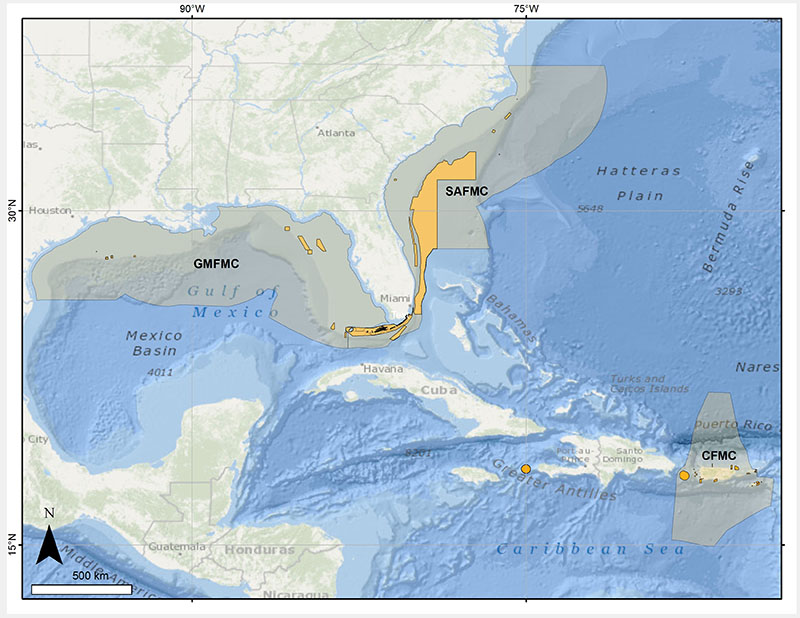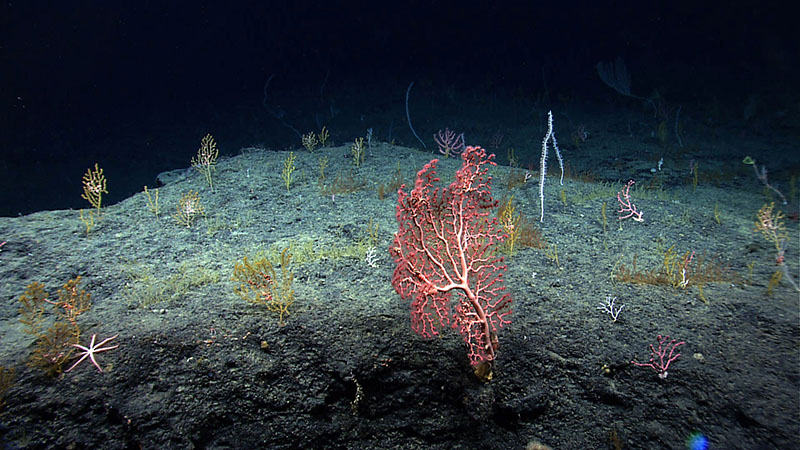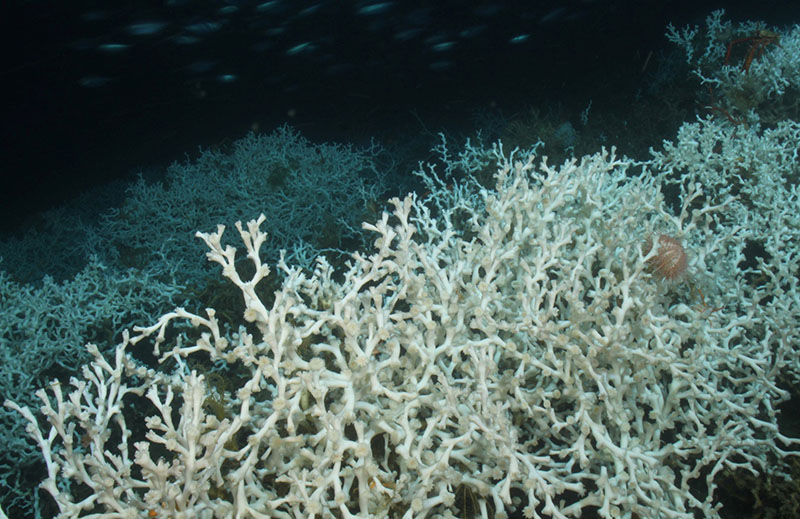
By Daniel Wagner, JHT Inc., and NOAA National Centers for Coastal Ocean Science

Map showing the three geographic regions in which the Southeast Deep Coral Initiative (SEDCI) will operate in 2016-2019. This area corresponds to the jurisdiction of three fishery management councils, shown in gray. Areas where deep-sea coral and sponge ecosystems are protected through fishing restrictions are shown in orange. Image courtesy of Daniel Wagner/NOAA. Download larger version (jpg, 2.6 MB).
In 2016, NOAA launched a new four-year initiative to study deep-sea coral and sponge ecosystems across the Southeast United States. This multidisciplinary effort, known as the Southeast Deep Coral Initiative (SEDCI), is led by a science team from multiple NOAA offices, including the National Ocean Service (NOS), the National Marine Fisheries Service (NMFS), the Office of Oceanic and Atmospheric Research (OAR), and the National Environmental Satellite, Data and Information Service (NESDIS), working in close collaboration with partners from multiple federal and academic institutions.
The geographic focus of SEDCI encompasses the U.S. federal waters of the South Atlantic Bight, the Gulf of Mexico, and the Caribbean Sea. This area corresponds to the cumulative extent of the jurisdictions of three fishery management councils, including the Caribbean, Gulf of Mexico, and South Atlantic Fishery Management Council (CFMC, GMFMC, SAFMC). Furthermore, this area includes several areas where deepwater corals are protected, including three national marine sanctuaries and various other marine protected areas.

A diverse assemblage of deep-sea corals on the West Florida Escarpment at a depth of 1,800 meters. Image courtesy of the NOAA Office of Ocean Exploration and Research, 2014 Gulf of Mexico Expedition. Download larger version (jpg, 1.4 MB).
The objectives of SEDCI are to collect scientific information that will support the management, conservation, and protection of deep-sea coral ecosystems across the Southeast United States. Specifically, the initiative strives to collect information that is most urgently needed by the agencies that manage deep-sea coral ecosystems, particularly the fishery management councils and national marine sanctuaries of the region.
There are several proposals for the establishment of new managed areas in deep waters of the Southeast United States, including potential new habitat areas of particular concern in the Gulf of Mexico and proposed expansions of the Flower Garden Banks National Marine Sanctuary, as well as new special management zones in the South Atlantic Bight.
In 2016-2019, SEDCI will support research in many of these proposed managed areas, and thereby provide important information that is needed to evaluate these proposals.

A dense aggregation of the deep-sea coral Lophelia pertusa at 500 meters depth in the northern Gulf of Mexico. Image courtesy of Lophelia II Reefs, Rigs, and Wrecks Expeditions, NOAA-OER and BOEM. Download larger version (jpg, 900 KB).
In order to achieve its objectives, SEDCI partners will conduct multiple research expeditions each year to map, survey, and sample deep-sea coral ecosystems using NOAA ships, deep-sea submersibles, and other equipment. Additionally, SEDCI supports complementary research projects focused on seafloor mapping, species identifications, habitat suitability monitoring, environmental monitoring, and data mining. These studies will provide important baseline information that is needed to support management efforts of deep-sea coral ecosystems across the Southeast United States.
The priorities of SEDCI are outlined in its science plan and were developed in consultation with fishery management councils, national marine sanctuaries, and partners from the Bureau of Ocean and Energy Management (BOEM), the U.S. Geological Survey (USGS), and various academic institutions. Funding for SEDCI is provided by NOAA, through the Deep-Sea Coral Research and Technology Program.